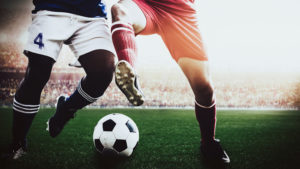Sports Hernias Are Often Misdiagnosed
Did you know that there’s a type of hernia that is specific to athletes and active people? Athletic pubalgia, more commonly known as a sports hernia, can be caused by the repetitive turning, twisting, and fast movements that come with tennis, basketball, wrestling, football, hockey, soccer, and even simple running. It develops when a tendon, a muscle, or a ligament is ripped.
If you’ve never heard of a sports hernia, you’re not alone. Many people haven’t, and it’s actually often misdiagnosed as a pulled muscle, a torn ligament, hypertension, a sprain, or even old age. But even though they are often misdiagnosed, sports hernias are common—and serious.
The pain that comes with one can affect the lower abdomen, groin, thigh, and the testicles, and it can make playing sports and engaging in activities very difficult. You may be able to feel it when you cough, sneeze, lift something, and of course, play.
Getting a Diagnosis
As mentioned above, sports hernias often get misdiagnosed or brushed off. This can be due to a few things.
For one, a sports hernia doesn’t create a bulge under the skin like a regular hernia does, and it in fact often doesn’t have a distinguishable trait at all. Even if an MRI is ordered and it does show the muscle and ligament tears, a medical professional may not be able to detect that it’s a sports hernia if they aren’t familiar with one.
The discomfort that comes with sports hernias can also mimic the symptoms of different conditions, which can throw a physician off the scent. Moreover, sports hernia pain can come and go, making the doctor believe that the patient is simply experiencing a minor pull or strain.
The best way to determine if you have a sports hernia is to visit a specialist in that field. It’s the only way to know if you’ve been correctly diagnosed—and if you do have one, a specialist is the best person to provide you with the proper treatment to get your body back on track.
A good sports hernia specialist will be able to diagnose it by listening to your symptoms and history, followed by a physical exam specified to sports hernias.
Types of Treatment
Once a sports hernia has been diagnosed, your doctor will begin treatment. Everyone’s body is different and heals in its own way, so it’s important to be patient and understanding to see what strategy works best.
Treatment for these hernias will typically include a non-operative trial in which you take a break from sports activities, takes anti-inflammatories, and undergoes a combination of heat, ice, massage, and physical therapy.
If you’re still experiencing pain after these methods, the doctor may suggest an operation, which will involve repairing the groin canal in the lower abdomen.
Never allow a medical doctor to fix a hernia using mesh. If this is suggested, find another sports hernia specialist who uses non-mesh methods.
Recovery and Healing
After the operation, you will need around six weeks of recovery time. During this period, you will need plenty of rest to allow your body to heal, and will also need to follow the doctor’s orders for any physical therapy exercises. Communication between you and your doctor during the recovery is very important.
It’s also important to understand that it’s okay to take longer than six weeks if you feel that your body is still recovering. Don’t push yourself too hard or you may do serious damage. Some post-operation patients have needed up to six months of recovery. It will all depend on the severity of the hernia, and perhaps how long it went untreated.
The main thing to remember is this: if you feel like you may have sports hernia (or even just similar symptoms), visit a reputable sports hernia specialist. If you do have one and it’s ignored, it can get worse if it isn’t treated.
While sports hernias can be tricky to diagnose for many doctors, there are specialists like Dr. William Brown who know exactly how to determine if you have one. Dr. Brown has been working with sports hernias since 1999, and is an expert at diagnosis, treatment, and recovery.
